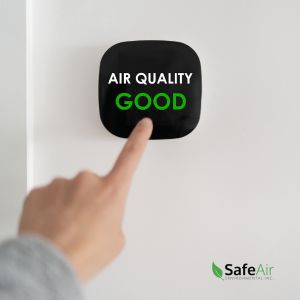Signs You Need Air Quality Testing in Toronto
Posted in Air Quality, on June 15, 2023
One of the most common indications during air quality testing in Toronto is mold growth. While many home air quality contaminants show up during testing, there’s a good reason why SafeAir finds so much mold in the GTA! In today’s article, we’ll share why mold testing in Toronto is an excellent addition to your annual maintenance routine and what benefits you can expect from indoor air quality testing.
Signs of Poor Indoor Air Quality
 If you’ve noticed a strange smell, you’ve most likely been experiencing poor indoor air quality for a while. Scent is one of the last indicators of poor home air quality to appear; it’s more common for there to be no smells, no visible effects, and a handful of subtle changes rather than a big glaring issue.
If you’ve noticed a strange smell, you’ve most likely been experiencing poor indoor air quality for a while. Scent is one of the last indicators of poor home air quality to appear; it’s more common for there to be no smells, no visible effects, and a handful of subtle changes rather than a big glaring issue.
At SafeAir, we tell our clients to monitor their home air quality for changes like:
- Poor airflow.
- Increased humidity.
- Condensation.
- Strange staining or marks.
- Areas of the floors, walls, or ceiling that lose rigidity and become soft.
- High heating and cooling bills.
Benefits of Indoor Air Quality Testing
The tricky part is that changes to your home’s atmosphere can be difficult to spot or can be passed off as seasonal changes, such as increased humidity in the summer. For many of our clients, it was only after air quality testing in Toronto that we discovered pollutants and contaminants in their homes — and relieved problems like poor airflow or condensation that were causing damage and discomfort.
While we know not to exercise hard during a smog alert, what about sleeping eight hours in indoor pollution? Many common indoor air quality issues in Toronto cause serious health effects and may contribute to adverse long-term health outcomes, making air quality testing key to comfort and safety.
Mold and Indoor Air Quality
Mold is common because our homes contain their favourite food (organic matter like wood, textiles, and paper) and water. Mold growth is a natural part of the decay cycle, but in our homes, it can cause massive physical damage and harms our health. Mold shows up in air quality tests because of its airborne spores — the tiny particles it needs to reproduce. Mold testing in Toronto can identify areas at risk or affected by mold growth and help you pinpoint active colonies.
Radon and Indoor Air Quality
While mold often has a distinct musty odour, radon gas doesn’t smell, taste, or have any physical presence. It’s a danger to indoor air quality because it’s the second most leading cause of lung cancer after cigarette smoking in North America. Because there are no visible or physical signs it’s in your home, you can coexist for years without feeling the effects — until it’s too late. Radon testing in Toronto can help determine if you’re at risk of this harmful radioactive gas.
Air Quality Testing in Toronto
Are you interested in improving your sleep, concentration and future-proofing your home from damage? Then it’s time to consider air quality testing in Toronto with SafeAir! Call us to learn more about specific testing (such as for mold or radon gas) or about generalized environmental assessments.

